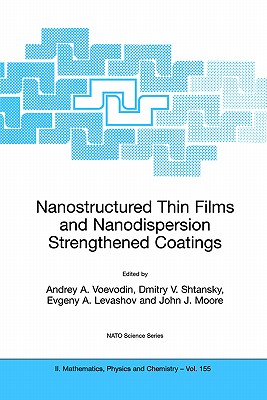
Nanostructured Thin Films and Nanodispersion Strengthened Coatings
Paperback
Series: NATO Science Series II: Mathematics, Physics and Chemistry, Book 155
ISBN13: 9781402022210
Publisher: Springer Nature
Published: Aug 26 2004
Pages: 322
Weight: 1.06
Height: 0.72 Width: 6.14 Depth: 9.21
Language: English
Also in
Technology & Engineering
Aircraft Versus Submarines, Third Edition: The Evolution of the Anti-Submarine Aircraft, 1912-1945
Price, Alfred
Hardcover
Musashi's Book of Five Rings: The Definitive Interpretation of Miyamoto Musashi's Classic Book of Strategy
Kaufman, Stephen F.
Musashi, Miyamoto
Paperback
Genesis: Artificial Intelligence, Hope, and the Human Spirit
Schmidt, Eric
Mundie, Craig
Kissinger, Henry a.
Hardcover
AI Snake Oil: What Artificial Intelligence Can Do, What It Can't, and How to Tell the Difference
Narayanan, Arvind
Kapoor, Sayash
Hardcover
The Coming Wave: Technology, Power, and the Twenty-First Century's Greatest Dilemma
Suleyman, Mustafa
Hardcover
The Home Blacksmith: Tools, Techniques, and 40 Practical Projects for the Home Blacksmith
Ridgway, Ryan
Paperback
ASE Technician Test Preparation Automotive Maintenance and Light Repair (G1)
Delmar Cengage Learning
Paperback
Improvised Munitions Black Book: Complete and Unabridged in One Volume: Complete and Unabridged in One Volume
U S Government
Paperback
Power and Progress: Our Thousand-Year Struggle Over Technology and Prosperity
Acemoglu, Daron
Johnson, Simon
Paperback
Welding for Beginners: Learn Everything You Need to Know to Weld, Cut, and Shape Metal in Your Home Studio
Christena, Stephen Blake
Paperback
Reentry: Spacex, Elon Musk, and the Reusable Rockets That Launched a Second Space Age
Berger, Eric
Hardcover
Midnight in Chernobyl: The Untold Story of the World's Greatest Nuclear Disaster
Higginbotham, Adam
Paperback
Farm and Workshop Welding, Third Revised Edition: Everything You Need to Know to Weld, Cut, and Shape Metal
Pearce, Andrew
Paperback
Engineering in Plain Sight: An Illustrated Field Guide to the Constructed Environment
Hillhouse, Grady
Hardcover
Watchdogs: Inspectors General and the Battle for Honest and Accountable Government
Fine, Glenn A.
Hardcover
Broken Money: Why Our Financial System is Failing Us and How We Can Make it Better
Alden, Lyn
Paperback
Atlas of AI: Power, Politics, and the Planetary Costs of Artificial Intelligence
Crawford, Kate
Paperback
Digital Dharma: How AI Can Elevate Spiritual Intelligence and Personal Well-Being
Chopra, Deepak
Hardcover
Killed by a Traffic Engineer: Shattering the Delusion that Science Underlies our Transportation System
Marshall, Wes
Paperback
The Lost Subways of North America: A Cartographic Guide to the Past, Present, and What Might Have Been
Berman, Jake
Hardcover
Dream Chasing: My Four Decades of Success and Failure with Walt Disney Imagineering
Weis, Bob
Hardcover
Ike's Road Trip: How Eisenhower's 1919 Convoy Paved the Way for the Roads We Travel
Black, Brian C.
Hardcover
The Pacific Circuit: A Globalized Account of the Battle for the Soul of an American City
Madrigal, Alexis
Hardcover
Pilot's Handbook of Aeronautical Knowledge (2025): Faa-H-8083-25c
Federal Aviation Administration (FAA)
Paperback
Smart Rivals: How Innovative Companies Play Games That Tech Giants Can't Win
Zhu, Feng
Cao, Bonnie Yining
Hardcover
Feeding the Machine: The Hidden Human Labor Powering A.I.
Muldoon, James
Graham, Mark
Cant, Callum
Hardcover
Star Bound: A Beginner's Guide to the American Space Program, from Goddard's Rockets to Goldilocks Planets and Everything in Between
Carney, Emily
McCandless, Bruce
Hardcover
Diesel Engines Test T2: Medium/Heavy Duty Truck Technician Certification
Delmar Cengage Learning
Paperback
How To Weld Scrap Metal Art: 30 Easy Welding Projects You Can Make At Home
The Welder, Barbie
Paperback
Machines a Visual History: 100 Machines and the Remarkable Stories Behind Each Invention
Chinea, Dominic
Hardcover
A Man and His Ship: America's Greatest Naval Architect and His Quest to Build the SS United States
Ujifusa, Steven
Paperback
Basic Butchering of Livestock & Game: Beef, Veal, Pork, Lamb, Poultry, Rabbit, Venison
Mettler, John J.
Paperback
Longitude: The True Story of a Lone Genius Who Solved the Greatest Scientific Problem of His Time
Sobel, Dava
Paperback
Tech Agnostic: How Technology Became the World's Most Powerful Religion, and Why It Desperately Needs a Reformation
Epstein, Greg
Hardcover
Quickstudy Pmp(r) Exam Content Outlline - Domain Test Prep: Laminated Reference Guide
Ellis, Aileen
Other
Bladesmithing From Scrap Metal: How to Make Knives With Leaf Springs, Saw Blades, Railroad Spikes, and Files
Sander, Wes
Paperback
Collection of Exercises for PLC Programming: 100 programming exercises from beginner to expert level
Antonsen, Tom Mejer
Paperback
Cadillac Desert: The American West and Its Disappearing Water, Revised Edition
Reisner, Marc
Paperback
Bringing Columbia Home: The Untold Story of a Lost Space Shuttle and Her Crew
Ward, Jonathan H.
Leinbach, Michael D.
Paperback
Dark Web: A Comprehensive Guide to Its Mechanics and Risks (The Insidious Happenings Lurking Right Beneath Our Internet Haven)
McClendon, Adolfo
Paperback
Ultimate Speed Secrets: The Complete Guide to High-Performance and Race Driving
Bentley, Ross
Paperback
Pilot's Handbook of Aeronautical Knowledge (2025): Faa-H-8083-25c
Federal Aviation Administration (FAA)
U S Department of Transportation
Paperback
The ABCs of EMP: A Practical Guide to Both Understanding and Surviving an EMP
Yago, Jeffrey R.
Paperback
The E-Myth HVAC Contractor: Why Most HVAC Companies Don't Work and What to Do About It
Gerber, Michael E.
Goodrich, Ken
Hardcover
Human + Machine, Updated and Expanded: Reimagining Work in the Age of AI
Daugherty, Paul R.
Wilson, H. James
Hardcover
City Limits: Infrastructure, Inequality, and the Future of America's Highways
Kimble, Megan
Hardcover
Introduction to Live Sound Reinforcement: The Science, the Art, and the Practice
Boyce, Teddy
Paperback
The Art and Science of Foodpairing: 10,000 Flavour Matches That Will Transform the Way You Eat
Coucquyt, Peter
Lahousse, Bernard
Langenbick, Johan
Hardcover
We the Poisoned: Exposing the Flint Water Crisis Cover-Up and the Poisoning of 100,000 Americans
Chariton, Jordan
Hardcover
Veg-Table: Recipes, Techniques, and Plant Science for Big-Flavored, Vegetable-Focused Meals
Sharma, Nik
Hardcover


 Sign-In
Sign-In Cart
Cart